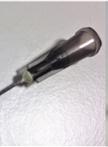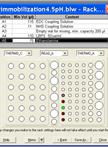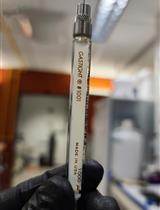- EN - English
- CN - 中文
Contemporaneous Measurement of Outer and Inner Membrane Permeability in Gram-negative Bacteria
革兰阴性菌中内外膜通透性的同期测定
(*contributed equally to this work) 发布: 2020年03月05日第10卷第5期 DOI: 10.21769/BioProtoc.3548 浏览次数: 6910
评审: Andrea PuharRon Saar DoverAnonymous reviewer(s)
Abstract
The emergence and rapid spread of multidrug resistance in bacteria have led to the urgent need for novel antibacterial agents. Membrane permeabilization is the mechanism for many antibacterial molecules that are being developed against gram-negative bacteria. Thus, to determine the efficacy of a potential antibacterial molecule, it is important to assess the change in bacterial membrane permeability after treatment. This study describes the protocol for the assays of outer and inner membrane permeability using the fluorescent probes N-phenyl-1-naphthylamine and propidium iodide. Compared with other experiments, such as electron microscopy and the assay of minimal bactericidal concentration, this methodology provides a simpler, faster, and cost-effective way of estimating the membrane-permeabilizing effect and bactericidal efficacy of antibacterial molecules. This study presents an optimized protocol with respect to the classical protocols by incubating bacteria with antibacterial molecules in the culture condition identical to that of antibacterial assays and then detecting the signal of the fluorescent probe in the buffer without broth and antibacterial molecules. This protocol avoids the effect of nutrient deficiency on the physiological status of bacteria and the interference of antibacterial molecules towards the fluorescent probe. Thus, this method can effectively and precisely evaluate the membrane permeability and match the results obtained from other antibacterial assays, such as minimum inhibitory concentration and time–kill curve assays.
Keywords: Gram-negative bacteria (革兰氏阴性菌)Background
Multidrug resistance in bacteria is a major public health crisis. Gram-negative bacteria currently pose the greatest threat to public health because of the emergence and rapid spread of carbapenem resistance. Consequently, new antibacterial molecules must be identified to combat this urgent problem. The outer membrane (OM) of gram-negative bacteria is not only the target of several traditional antibiotics to exert antibacterial activities but also of novel therapeutic agents, such as antimicrobial peptides (AMPs). These molecules can disrupt the OM integrity and cause bacterial lysis through permeabilization. Thus, detecting the permeability of the outer and inner membranes is a direct and important means of assessing the efficacy of antibacterial molecules. Electron microscopy is usually applied to observe the morphological changes in OM, and the assay of minimal bactericidal concentration is used to examine bacterial viability after treatment. However, these methods are time-consuming and cannot reflect the real-time change in membrane permeability. In this protocol, we provide a convenient and fast approach for evaluating the antibacterial efficacy of agents with potential membrane-permeabilizing effect by using the fluorescent probes N-phenyl-1-naphthylamine (NPN) and propidium iodide (PI).
NPN is a hydrophobic dye that dissolves sparingly in water with very low fluorescent emission. However, the fluorescence intensity increases sharply when NPN binds with nonpolar substances. The intact OM efficiently blocks NPN out of bacteria to ensure that NPN cannot bind to the hydrophobic tail of phospholipids. By contrast, a strong fluorescence emission can be detected when an OM rupture occurs. Thus, the change in fluorescence intensity of NPN can reflect the efficacy of antibacterial molecules on increasing the permeability of OM. PI is a red-fluorescent nucleic acid stain that can bind to DNA and RNA between the bases. Binding to DNA and RNA leads to an enhancement of PI fluorescence by 20- to 30-fold compared with that in aqueous solutions. Given that PI is a membrane-impermeant stain, it can only label bacteria with a compromised inner membrane (IM). Thus, PI is used in this protocol to determine the change in IM permeability after the treatment of antibacterial molecules.
In most of the related studies, the bacterial OM/IM permeability assay is conducted in a 96-well optical-bottom black plate. Bacteria, fluorescent probe, and antibacterial molecules are mixed together and co-cultured throughout the assay, during which the fluorescence intensity is detected at each time point. To avoid the high background fluorescence emitted by the bacterial culture media, the assay buffer (5 mM HEPES, pH 7.2) is used instead. In this case, bacteria grow under an innutritious condition compared with that of the antibacterial assays such as minimum inhibitory concentration and time–kill curve assays, which may affect the physiological status of bacteria. And some antibacterial molecules may also interfere with the function and performance of the fluorescent probe. As a result, the assay may not exactly reflect the change in permeability caused by the antibacterial molecules. The current work presents an optimized procedure with respect to the previously reported protocols (Ma et al., 2016b; Yarlagadda et al., 2016; Krishnamurthy et al., 2019) by culturing bacteria and exposing them to antibacterial molecules in the same medium as those of other antibacterial assays, harvesting bacteria, and detecting the fluorescent yield in the assay buffer at each time point. This methodology can evaluate the membrane permeability more efficiently and precisely and better match the results obtained from the antibacterial assays.
Materials and Reagents
- Pipette tips
- 1.5 ml Eppendorf tube (Eppendorf Safe-Lock, catalog number: 0 22363204 )
- Steritop 0.22 μm filter unit (Millipore Millex-GP, catalog number: SLGP033RB )
- Flat-bottomed polystyrene 96-well cell culture plates, 0.2 ml well-volume (Corning, Costar®, catalog number: 3599 )
- Glass culture tube 20 mm x 150 mm (sterilized by autoclaving)
- 50 ml glass conical flask (sterilized by autoclaving) (ShuNiu, China)
- E. coli XJ141026 (Isolated from Xijing Hospital)
Note: Other types of E. coli can also be used. - Luria–Bertani (LB) broth (BD/Difco, catalog number: 244620 )
- N-Phenyl-1-naphthylamine (NPN) (Sigma-Aldrich, catalog number: 104043 )
- Propidium iodide (PI (Sigma-Aldrich, catalog number: P4170 )
- Thanatin (synthesized and purified to over 98%)
Note: Thanatin was synthesized with the solid-phase method by applying the Fmoc (9-fluorenylmethyloxycarbonyl) active ester chemistry of as described previously (Fehlbaum et al., 1996). Other AMPs of the experimenter’s choice could also be used instead of thanatin. - Glucose (Sigma-Aldrich, catalog number: G8270 )
- 1 M HEPES solution (Sigma-Aldrich, catalog number: H0887 )
- 10x PBS stock (Life Technologies, Gibco®, catalog number: 70011-044 )
- Acetone (Sigma-Aldrich, catalog number: 650501 )
- Milli-Q filtered water (ddH2O)
- 5 mM HEPES and 5 mM glucose buffer (pH = 7.2) (see Recipes)
Equipment
- Pipettes
- Shaking incubator (Zhicheng, model: ZHWY-200D )
- Static incubators (Taisite Instrument, model: DH4000BII )
- Microplate spectrophotometer (BioTek, model: PowerWave HT )
- Tabletop centrifuge machine (Hanil Science Industrial, model: Smart R17 )
- Fluorescence spectrophotometer (Hitachi, model: F-2500 )
- Water purification system (Millipore, model: Milli-Q Advantage A10 )
- Quartz cuvettes with 1 cm path length (Starna Cells, catalog number: 3-Q-10 )
Software
- Gen 5 (Biotek, USA)
- FL Solutions 2.0 (Hitachi, Japan)
- Excel 2016 (Microsoft, USA)
- Prism 8.0 (GraphPad, USA)
Procedure
文章信息
版权信息
© 2020 The Authors; exclusive licensee Bio-protocol LLC.
如何引用
Ma, B., Fang, C., Zhang, J., Wang, M., Luo, X. and Hou, Z. (2020). Contemporaneous Measurement of Outer and Inner Membrane Permeability in Gram-negative Bacteria. Bio-protocol 10(5): e3548. DOI: 10.21769/BioProtoc.3548.
分类
微生物学 > 抗微生物试验 > 抗细菌试验
生物化学 > 脂质 > 膜脂
生物化学 > 蛋白质 > 相互作用 > 蛋白质-脂质相互作用
您对这篇实验方法有问题吗?
在此处发布您的问题,我们将邀请本文作者来回答。同时,我们会将您的问题发布到Bio-protocol Exchange,以便寻求社区成员的帮助。
Share
Bluesky
X
Copy link













